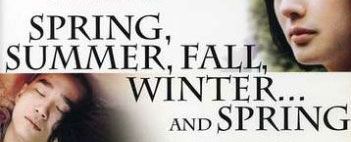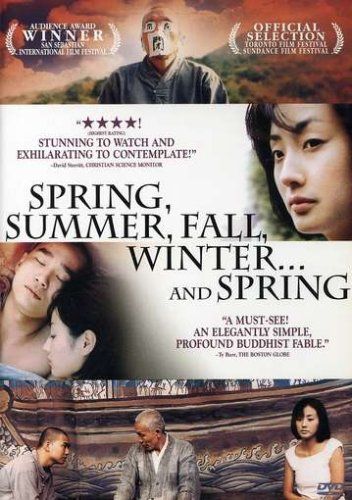This is a very cool movie. We normally associate a plot full of twists and turns with something in the Hitchcockian style, such as a man-on-the-run thriller starring Cary Grant or Harrison Ford. So, being unable to guess what happens next is not the usual hallmark of an art film that is told largely in static, meditative master shots and, to top it off, takes place in and around a holy monk's temple that is floating in the middle of a secluded lake. But, provided one can rewire one's brain out of its predilection for thirty-seven edits per minute and sound design that seeks to most effectively convey the sound of a truck transforming into a cyborg, there are a lot of rewards to be had in this quiet, strange, elegantly simple and, yes, in its own way, suspenseful morality tale from Korea.
The five seasons referenced in the title take us from one man's boyhood under the tutelage of a Buddhist master, to his straying from the teachings and, finally, to his return. In the film's storyline, at least ten years pass between each season, and therein lays writer/director Ki-duk-Kim's ingenious evocation of suspense. As the events prior to each change of season become more and more ominous, our imagining of what might have filled the gaps in between fuels an unconscious sense of urgency. We marvel at how this gently-made film can be taking us to so many unexpected places.
Little can be said about most of the story's events without depriving the viewer of some rich discoveries. It begins in spring as a boy monk (Jae-kyeong Seo) receives a harsh lesson in compassion from his master, the Old Monk (Yeong-su Oh) after he is caught taunting defenseless animals. Summer opens ten years later, as the boy, now a young adult (Young-min Kim), becomes obsessed with an ill young woman (Yeo-jin Ha) whose mother has left her with the old monk for a regimen of holistic healing. His obsession leads to passion, which, in turn, leads to estrangement from his master and a rejection of his ways. Fall adds ten more years to his story, as he returns under troubling circumstances. Winter finds him back yet again, in a haunting, wordless sequence involving a new patient whose weeping face is covered in cloth, presumably to avoid passing her condition onto the little baby she has also brought with her. It is a surreal, miniature tour-de-force. Finally, spring brings with it an eternal return: more, as the wise man said, I cannot say, but director Kim's uncomplicated yet profound message about the cycle of life speaks volumes and will produce a sigh of recognition, beauty and bitterness all at once.
Each season opens with the visual of opening doors. The doors are painted with images of ancient warriors, and the doorway is the portal between the mainland wooded area and the mysterious lake on which the monk's house floats. A small rowboat (also with painted images on its side-the film revels in such details) is what gets the monk and the boy from the house to the woods, where they pick healing herbs or go on a pilgrimage. These woods are also another kind of entryway, through which the outside world is able to seek out the monk and his wisdom. The old monk's face is fascinating to watch, and, in fact, each time the film breaks from its painterly compositions of the lake and its rocky outcroppings to dwell on a human visage, we are pulled even further into its spell.
Patience is required to let the film do its work on your psyche, but the patience pays off in unforgettable images like the old monk painting hundreds of Asian characters onto his dock with a cat's tail dipped in ink, and then commanding his pupil to carve each character out with a knife as a penance for his wrongdoing. Twice, the student is tasked with walking a great distance while burdened with a heavy stone tied to his waist. And the shots of the floating monk's house taken from a distant hilltop (the viewpoint of the student's several symbolic treks to the other side) are breathtaking.
Spring, Summer, Fall, Winter...and Spring gets under your skin. Stay with this exceptional jewel of a movie, my child, and your soul will find much to feed upon.
James Napoli is an author, filmmaker and teacher whose third book Violation! The Ultimate Ticket Book is now available.




.jpg)